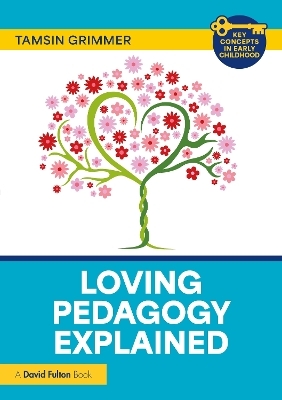
Loving Pedagogy Explained
Routledge (Verlag)
978-1-032-83663-8 (ISBN)
What does it mean to adopt a loving pedagogy within early childhood? Have you ever wondered what terms like attunement really mean?
Loving Pedagogy Explained highlights the importance of developing a loving pedagogy and explains key terms used within this approach. Unpicking terms like advocacy, attachment, attunement, belonging, compassion, emotion coaching, empathy and empowerment, this book uses practical examples and case studies to explain what it means in practice when we adopt this approach. It also considers how we might adopt a loving pedagogy in relation to our policies, describing this ethos in more detail.
Divided into two parts, the first provides a brief overview of the key terms used when describing a loving pedagogy alongside examples of what they mean in practice. Part two looks more broadly at the ethos of early childhood settings and unpicks various aspects of a loving pedagogy, including: how to write a loving pedagogy policy, how a loving pedagogy links to supporting behaviour, how we can nurture our children through developing a loving pedagogy and staff training and development.
Part of the Key Concepts in Early Childhood Series, this is essential reading for early years practitioners and students who want to know and understand the importance of adopting a loving pedagogy within early childhood.
Tamsin Grimmer is an experienced consultant and trainer, a director of Linden Learning and a Principal Lecturer at Norland College. She is based in Wiltshire, UK. Tamsin has written several early childhood books, including Developing a Loving Pedagogy in the Early Years, Nurturing Self-Regulation in Early Childhood and Supporting Behaviour and Emotions in the Early Years.
Acknowledgements
Note from the series editor
Introduction
Part 1 - Explaining terms
Acknowledging feelings and emotions
Acceptance
Advocacy
Agency
Attachment
Attunement
Belonging and welcoming
Behaviour
Caring
Communication (including non-verbal)
Compassion and sympathy
Consent
Co-construction
Co-regulation
Duty of Care or in ‘Loco Parentis’
Emotion coaching
Empathy
Empowerment
Familiarity
Forgiveness
Generosity
Gentleness
Hold in mind
Inclusive
Independence
Joy
Kindness
Listening
Love languages (words of affirmation, quality time, gifts, touch and acts of service)
Nurture
Patience
Professional love
Relationship and friendship
Respect
Responsive
Safe and secure
Safeguarding
Self-compassion
Self-esteem and self-worth
Self-regulation
Touch
Unconditional love
Voice of the child
Warmth
Wellbeing
Further reading and resources
Part 2 – Further unpicking this ethos
The rights of the child in relation to a loving pedagogy
The importance of knowing what we believe – our professional identity
How to write a loving pedagogy policy
Reflecting upon our loving pedagogy
What adopting a loving pedagogy means in terms of relationships
How a loving pedagogy links to supporting behaviour
The implications of adopting a loving pedagogy for our safeguarding practices
What adopting a loving pedagogy means in terms of creating an enabling environment
How we can nurture our children through developing a loving pedagogy
How we can engage parents and work in partnership with them in relation to a loving pedagogy
Staff training and development
Conclusion
References
| Erscheinungsdatum | 14.11.2024 |
|---|---|
| Reihe/Serie | Key Concepts in Early Childhood |
| Zusatzinfo | 33 Halftones, color; 33 Illustrations, color |
| Verlagsort | London |
| Sprache | englisch |
| Maße | 148 x 210 mm |
| Themenwelt | Sozialwissenschaften ► Pädagogik ► Schulpädagogik / Grundschule |
| Sozialwissenschaften ► Pädagogik ► Vorschulpädagogik | |
| ISBN-10 | 1-032-83663-6 / 1032836636 |
| ISBN-13 | 978-1-032-83663-8 / 9781032836638 |
| Zustand | Neuware |
| Informationen gemäß Produktsicherheitsverordnung (GPSR) | |
| Haben Sie eine Frage zum Produkt? |
aus dem Bereich


